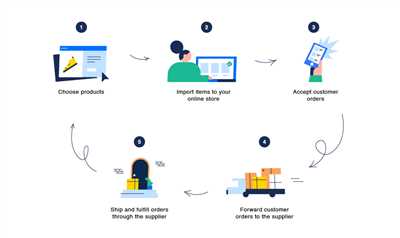
Starting an online store is a great way to make your business more accessible to customers from all over the country, and even the world. But how do you go about building and establishing your own webshop? In this step-by-step guide, we will walk you through the essential things you need to consider when opening an ecommerce store.
Step 1: Plan your business
Before diving into the world of webshops, it is important to have a clear plan in mind. Determine what products or services you want to sell, and decide on your business model, whether it’s dropshipping, inventory-based, or something else entirely. This will help you structure your website and set the right tone for your brand.
Step 2: Choose an ecommerce platform
Once you have a plan in place, it’s time to choose an ecommerce platform that suits your needs. There are many options available, but make sure to consider factors such as ease of use, design options, and integration with other tools and platforms.
Step 3: Design your webshop
The design of your webshop is an important part of attracting and retaining customers. Make sure it has a clean and user-friendly interface, and showcases your products in an appealing way. Don’t forget to include a clear and easy-to-use navigation menu, so customers can find what they’re looking for quickly and easily.
Step 4: Ensure secure online payments
When selling products online, it is crucial to ensure that your customers’ payment details are safe and secure. Choose a payment gateway that offers encryption and fraud protection to give your customers peace of mind when making a purchase.
Step 5: Establish shipping and fulfilment options
Decide how you will handle shipping and fulfilment for your products. This includes determining which countries you will ship to, what shipping options you will offer, and how you will handle returns in case of any issues.
Step 6: Set up terms and conditions
Having clear terms and conditions is important for any online business. Define your return policy, privacy policy, and other legal requirements to protect both your business and your customers.
Step 7: Collect and manage customer data
Collecting and managing customer data is essential for running a successful webshop. Ensure you have a system in place to collect customer details, such as email addresses, and use them for targeted marketing campaigns and to provide personalized customer experiences.
Step 8: Implement marketing strategies
Marketing plays a crucial role in driving traffic to your webshop and increasing sales. Utilize various marketing channels, such as social media, email marketing, and search engine optimization, to promote your products and attract potential customers.
Step 9: Optimize your webshop for mobile
In today’s mobile-driven world, it is essential to have a webshop that is optimized for mobile devices. Make sure your website is responsive and provides a seamless user experience, regardless of the device your customers are using.
Step 10: Monitor and adjust
Once your webshop is up and running, the work doesn’t stop there. Regularly monitor your site’s performance, analyze data, and make necessary adjustments to improve user experience and increase conversions.
By following these 10 steps, you’ll be well on your way to building and running a successful webshop. Remember, it’s not only about the design and functionality of your site, but also about planning, marketing, and continuously improving to meet the needs and expectations of your customers.
A 10-step Guide to Starting an Online Store

Starting an online store requires careful planning and attention to detail. In this 10-step guide, we will walk you through the essential steps to help you establish an online business that not only sells products but also gives you an edge over your competitors.
Step 1: Decide on your business structure
Before you open your webshop, you need to decide on the structure of your business. Will you operate as a sole proprietorship, partnership, or a limited liability company? Each structure has its own advantages and disadvantages, so make sure to research and choose the one that suits your needs best.
Step 2: Determine what products to sell
When starting an online store, it’s crucial to choose the right products to sell. Conduct market research to identify popular and profitable niches. Consider your target audience, trends, and competitors in order to select products that have a good demand and potential for growth.
Step 3: Establish your business presence online
Building a professional and engaging website is a key part of starting an online store. Invest in a user-friendly design that reflects your brand and showcases your products in an appealing way. Ensure that your site is mobile responsive and optimized for search engines to drive more traffic.
Step 4: Set up your logistics and fulfilment
Decide on the logistics and fulfilment options for your online store. Will you handle the shipping and storage of products yourself or outsource it to a third-party provider? Consider the costs, time, and resources required for each option and choose the one that suits your business model.
Step 5: Create terms and conditions, and return policy
Protect your business by creating clear terms and conditions that outline the rights and responsibilities of both you and your customers. Additionally, establish a return policy that addresses the process for returning products and issuing refunds.
Step 6: Find reliable suppliers
To ensure the quality and availability of your products, it’s important to find reliable suppliers. Research and negotiate with different suppliers to get the best pricing and terms. Consider factors such as product quality, delivery times, and minimum order quantity.
Step 7: Market your online store
Marketing is an essential part of starting an online store. Utilize various marketing channels such as social media, email marketing, and search engine optimization to reach your target audience and drive traffic to your site. Consider using paid advertising options to get your business in front of more potential customers.
Step 8: Build a customer support system
Your customers are the lifeblood of your online store, so it’s crucial to provide excellent customer support. Implement a system that allows customers to contact you with their questions and concerns. Respond promptly and courteously to build trust and loyalty.
Step 9: Process and fulfil orders
Once your online store is up and running, you’ll start receiving orders. Have a clear process in place to efficiently process and fulfil these orders. Make sure to communicate with customers regarding their order status and provide tracking information for shipments.
Step 10: Continuously evaluate and improve
Starting an online store is an ongoing process, and it’s important to continuously evaluate and improve your business. Monitor your website metrics, sales data, and customer feedback to identify areas for improvement. Stay updated with the latest trends and technologies in ecommerce to stay ahead of the competition.
By following these 10 steps, you’ll be on your way to starting a successful online store. Remember, starting an online business requires dedication, hard work, and adaptability, but with the right plan and strategies in place, you can achieve your entrepreneurial goals.
A 10-step Guide to Starting an Online Store

Starting an online store can be an exciting venture, but it requires careful planning and consideration. In this 10-step guide, we will walk you through the essential steps to help you build a successful online business.
| Step 1: Decide What to Sell | First, you need to decide what products or services you want to sell on your online store. Consider your interests, market demand, and competition while choosing your niche. |
| Step 2: Research the Market | Do thorough research to understand the market conditions for your chosen products. Analyze competitors, target audience, and pricing strategies to ensure your business will be profitable. |
| Step 3: Create a Business Plan | Develop a comprehensive business plan that outlines your goals, marketing strategies, and financial projections. This plan will serve as a roadmap for your online store’s success. |
| Step 4: Establish Your Online Presence | Designing and building your online store requires a well-structured website that is user-friendly and visually appealing. Invest in a reliable eCommerce platform that gives you options for customization. |
| Step 5: Ensure Order Fulfillment | Set up a system to handle orders, shipping, and logistics. Establish terms and conditions for returns and exchanges to ensure customer satisfaction. |
| Step 6: Drive Traffic to Your Site | Implement marketing strategies to attract visitors to your online store. Utilize social media, content marketing, and search engine optimization to increase your online visibility. |
| Step 7: Build a Customer Base | Engage with your customers and build meaningful relationships. Offer excellent customer service, personalized recommendations, and loyalty programs to encourage repeat purchases. |
| Step 8: Analyze Data and Make Improvements | Regularly analyze data from your online store to identify trends and areas for improvement. Use this information to optimize your marketing campaigns and enhance your customer’s shopping experience. |
| Step 9: Adapt and Evolve | Stay up-to-date with the latest eCommerce trends and technologies. Continuously adapt your business model and offerings to meet the changing needs and preferences of your target audience. |
| Step 10: Scale and Expand | Once your online store is established and generating sales, explore opportunities for growth. Consider expanding into new markets, offering more products or services, and optimizing your logistics and shipping processes. |
By following these 10 steps, you can lay a strong foundation for your online store and increase the chances of its success. Remember, starting an online business requires dedication, hard work, and continuous learning, but the rewards can be significant.
10 Essential Steps to Starting an Online Store
Starting an online store requires careful planning and consideration. You need to have a clear business plan in place and understand how to turn your ideas into a profitable venture. Here are 10 essential steps to help guide you through the process of starting your own online store.
1. Decide on your business model: Determine what products or services you want to sell and what kind of online store you want to build. Will you be selling physical products or digital downloads? Will you be dropshipping or holding inventory? Choose a business model that suits your preferences and resources.
2. Conduct market research: Research your target market and identify the needs and preferences of your potential customers. This will help you design and structure your online store to cater to those specific requirements.
3. Choose an ecommerce platform: There are various options available when it comes to choosing an ecommerce platform. Consider factors such as ease of use, available features, and pricing options. Look for a platform that gives you the flexibility and functionality you need to run your online store.
4. Build your online store: Once you have chosen an ecommerce platform, start building your online store. Customize its design according to your branding requirements and create a user-friendly interface for seamless navigation.
5. Set up logistics and order fulfilment: Establish a system for managing logistics and order fulfilment. This includes setting up shipping options, choosing the right shipping partners, and ensuring that your products reach customers on time and in good condition.
6. Establish customer support: Provide excellent customer support to ensure a positive buying experience. Set up channels for customers to reach out for assistance and address any queries or concerns they may have promptly and effectively.
7. Secure customer data: Implement proper security measures to protect customer data and sensitive information. Use encryption and secure payment gateways to ensure customer details are safe from unauthorized access.
8. Develop a marketing strategy: Create a comprehensive marketing strategy to drive traffic to your online store. Utilize various online marketing channels such as social media, email marketing, and search engine optimization to increase visibility and attract potential customers.
9. Establish return and refund policies: Clearly define your returns and refund policies to set expectations for your customers. Make it easy for customers to initiate returns and refunds, and ensure a smooth and hassle-free process.
10. Monitor and optimize: Continuously monitor and analyze data to identify areas for improvement. Keep track of customer behavior, sales performance, and website analytics to make data-driven decisions and optimize your online store for better results.
By following these 10 essential steps, you can establish a successful online store that not only attracts customers but also gives them a seamless and satisfying shopping experience.
How to sell online: Choosing where to open your eCommerce store
When starting an online business, one of the essential things to consider is where to open your eCommerce store. The platform you choose will determine the structure and terms of your business, as well as how you market and fulfil orders for your products.
Here, we’ll guide you through the 10-step process of choosing the right platform for your online store:
- Plan your business: Before you decide where to open your eCommerce store, you need to have a clear plan and understanding of what your business requires. Consider factors such as the number of products you’ll be selling, your target customer base, and any specific logistic or design details you have in mind.
- Research eCommerce platforms: There are numerous options available for businesses starting an online store. Research different eCommerce platforms to find the ones that align with your business goals and requirements.
- Consider established platforms: While it may be tempting to go with a lesser-known platform, choosing an established eCommerce platform gives you more assurance in terms of reliability and security.
- Evaluate features: Look at the features and capabilities offered by each platform. Consider whether they have the functionalities you need for your business, such as inventory management, SEO optimization, or integration with other software.
- Assess cost and pricing: Compare the pricing models of different eCommerce platforms. Look into the fees they charge for transactions, monthly subscriptions, or additional services. Ensure that the platform aligns with your budget and provides value for the cost.
- Consider customization: If you have specific design requirements or want to create a unique online store, consider the level of customization each platform offers. Some platforms might restrict your ability to customize certain aspects of your site.
- Think about traffic and marketing: Consider how each platform supports marketing efforts and drives traffic to your online store. Look into their SEO capabilities, social media integrations, and any built-in marketing tools.
- Look into shipping and fulfilment: If you’re planning to ship products to customers, check the platform’s shipping and fulfilment options. Look for built-in shipping calculators, integration with shipping carriers, and the ability to handle returns.
- Read user reviews: To get a better understanding of each platform’s performance and user experience, read reviews from other eCommerce businesses. Pay attention to any common issues or concerns mentioned.
- Make a decision: Based on your research and analysis, decide on the eCommerce platform that best fits your business needs, offers the features you require, and aligns with your budget.
In conclusion, choosing where to open your eCommerce store is a crucial part of starting an online business. Take your time to research and evaluate different platforms to ensure you make the right decision, considering factors like cost, features, customization, and marketing capabilities. By selecting the right platform, you’ll be well on your way to building a successful online store.

